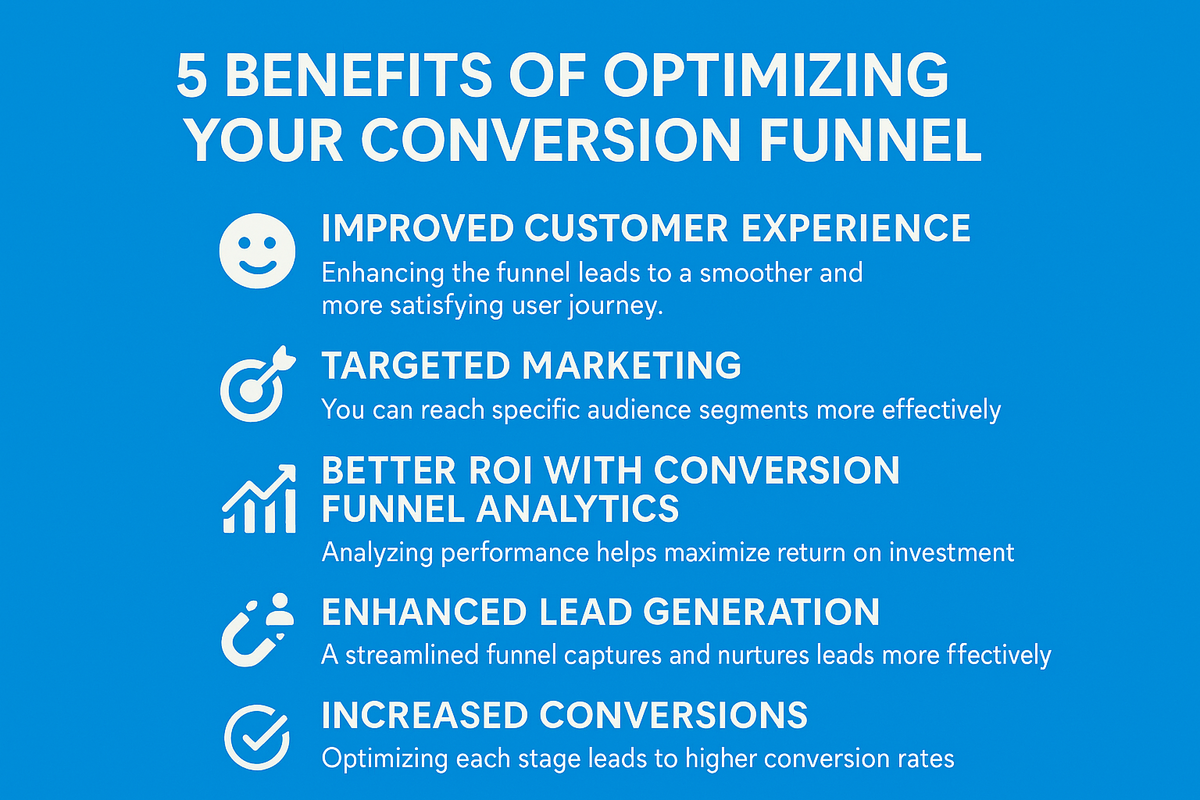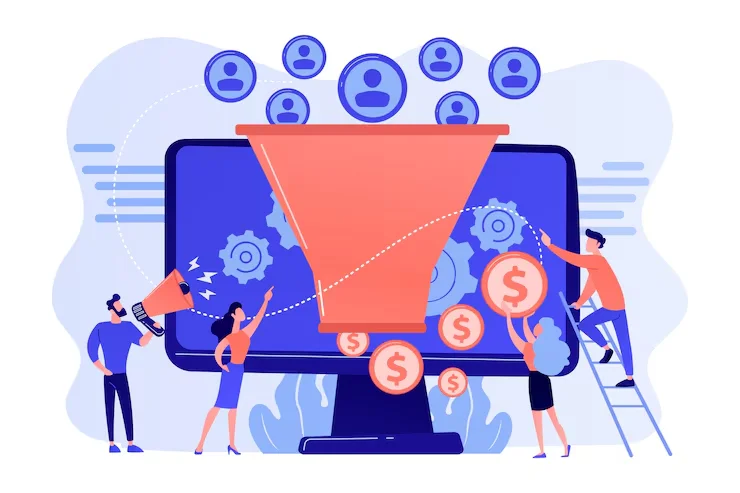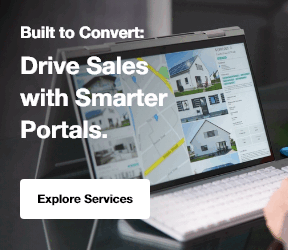When people talk about a conversion funnel, they’re really describing the path a customer takes from the moment they first discover your brand to the point where they finally take action—whether that’s buying a product, signing up for a newsletter, or filling out a form.
It’s called a “funnel” because the process starts broad at the top, pulling in a wide audience, and then naturally narrows as some people drop off along the way.
Only a smaller percentage makes it to the end goal.
Why does this matter? Because understanding the funnel helps businesses see where potential customers are losing interest and what can be done to fix it.
By breaking it down into clear stages, awareness, interest, consideration, intent, and conversion, you get a roadmap to improve every step of the customer journey.
In today’s crowded digital world, where buyers interact with brands across multiple touchpoints, visualizing this funnel gives you clarity.
It shows where your resources are best spent, highlights weak spots, and helps align your marketing and sales strategies with real, measurable results.
In this post, we will explore why conversion funnel matters and how a well-optimized funnel not only reduces drop-offs but also delivers a smoother customer experience, and that means a better return on your investment.
What is a Conversion Funnel?
A conversion funnel is a structured journey that guides site visitors through the content marketing process, from the landing page all the way to the final conversion, whether it’s a purchase, subscription, or other desired action.
The goal of the funnel is to capture and engage visitors with relevant, valuable content at each stage. Each stage has a specific purpose, but all are connected to move the user closer to the final conversion.
It’s called a "funnel" because, much like the shape of a funnel, the number of potential customers is widest at the top (starting with visitors on the landing page, often the home page) and narrows as they move through each subsequent stage.
Explore Our Digital Marketing Services!
Why Conversion Funnels Matter?
A conversion funnel is a marketing model that illustrates the journey a potential customer takes from initial awareness to the final purchase. It helps businesses optimize their strategies at each stage to improve conversions and drive growth.
Here’s why conversion funnels matter:
1. Tool for Business Growth
Conversion funnels are more than just a theoretical model; they directly impact business growth by connecting marketing and sales activities to measurable outcomes.
For example, using sales funnel examples, businesses can learn from real-world applications of this framework to better predict and drive conversion rates.
2. Mapping the Customer Journey
Funnels help businesses track how effectively they move prospects from awareness to conversion and highlight areas for improvement, driving better understanding of AI SEO software effectiveness.
This link between funnel performance and revenue growth makes it an essential framework.
3. Data-Driven Decision Making
Funnels provide critical insights into the number of people entering each stage, how many drop off, and why.
Using metrics like conversion rate, bounce rate, and customer lifetime value, businesses can make informed adjustments instead of relying on guesswork.
This leads to optimized marketing spend and resource allocation.
4. Customer-Centric Marketing
Funnels promote a customer-first approach by focusing on the needs, behaviors, and concerns of customers at each stage.
This allows businesses to tailor communication and offers, building trust and encouraging long-term loyalty.
5. Customer Lifecycle Management
The funnel framework supports every stage of the customer lifecycle, from acquisition with targeted campaigns, to nurturing with personalized content, and retention through excellent service and engagement.
What’s the Difference Between a Conversion Funnel and a Customer Journey?
When discussing customer engagement, two terms often come up: the conversion funnel and the customer journey. Although they both map out how customers interact with a brand, they differ in terms of scope and focus.
Let’s break down what sets them apart.
Customer Journey: The Big Picture
The customer journey refers to the comprehensive experience a customer has with your brand, from the initial awareness stage through to post-purchase interactions. It includes every touchpoint the customer encounters along the way, such as discovering your product through an ad, comparing options, deciding to buy, and eventually becoming a loyal customer.
The customer journey provides a holistic view of the customer’s path and can span a long period. It involves:
- Initial awareness sparked by ads or word-of-mouth
- Research and consideration, where the customer weighs different options
- The decision-making process leading to a purchase
- Post-purchase engagement, including loyalty and advocacy
The customer journey takes a broad perspective, offering insight into how customers engage with your brand over time and helping identify opportunities for long-term relationship building.
On the other hand, digital transformation agencies like Centric helps businesses refine their strategy at each stage through personalized, data-driven approaches, focusing on maximizing results with performance marketing and customer-centric experiences. This differentiation allows businesses to tailor their approach, ensuring that customers move efficiently through the funnel toward conversion.
Conversion Funnel: The Path to Conversion
On the other hand, the conversion funnel focuses specifically on the steps a potential customer takes toward completing a desired action, such as purchasing a product, signing up for an email, or downloading a resource. It is a more narrow and targeted framework designed to drive a customer toward conversion.
The conversion funnel can be broken down into three main stages:
- Top of the funnel (TOFU): Awareness—This is where the customer first becomes aware of your brand.
- Middle of the funnel (MOFU): Interest and desire—This stage is about nurturing the prospect's interest in your product or service.
- Bottom of the funnel (BOFU): Action—This is where the prospect takes the final step and converts, whether that’s making a purchase or completing another desired action.
The conversion funnel serves as a guide for marketers to keep customers progressing through these stages toward conversion, offering a clear, efficient path to that goal.
Are Conversion Funnels, Sales Funnels, and Marketing Funnels the Same Thing?
You might hear terms like conversion funnels, sales funnels, and marketing funnels used interchangeably, but they are not the same. Each type of funnel serves a distinct purpose within the broader customer engagement strategy.
Conversion Funnel
A conversion funnel focuses specifically on the steps a customer takes toward completing a desired action, such as making a purchase or signing up for a newsletter. The goal of the conversion funnel is to guide prospects efficiently toward conversion.
Sales Funnel
The sales funnel is a more focused subset of the conversion funnel, concentrating on the path from awareness to the decision-making process leading to a sale. It tracks how a lead progresses through stages like awareness, consideration, and decision, with the primary goal being to close the deal and drive revenue.
Marketing Funnel
The marketing funnel takes a broader approach and encompasses the entire customer journey, from the first point of contact with your brand to post-purchase engagement. It includes elements of both the conversion funnel and sales funnel, but it also focuses on brand awareness, nurturing leads, and building customer loyalty.
In many cases, the marketing funnel includes both conversion and sales funnels within it, allowing marketers to track and optimize every stage of the customer’s journey.
Five Main Stages of the Conversion Funnel
The conversion funnel is typically divided into several stages that represent how prospects move from being strangers to becoming loyal customers.
Each stage requires a different approach, set of tools, and measurement metrics. Let’s dive into the stages in detail.
1. Awareness Stage (Top of Funnel – TOFU)
The Awareness Stage (Top of Funnel – TOFU) marks the starting point of the conversion funnel, where the focus is on making potential customers aware of your brand through marketing tactics rather than pushing for immediate sales.
At this stage, many people don’t yet recognize their problem or need, so businesses must invest in visibility, education, and credibility to create a strong first impression. The aim is to capture attention broadly and start building recognition through consistent exposure.
Common strategies include:
- Social Media Ads on platforms like Facebook, Instagram, LinkedIn, and TikTok to generate brand recall and reach wide audiences, ultimately improving SEO and understanding what is CTA.
- SEO & Blogs, where valuable, keyword-rich articles, guides, or tutorials help prospects discover your brand organically.
- PR & Influencer Marketing to leverage authority, gain trust, and expand reach quickly through partnerships or media coverage.
Performance at this stage is typically tracked with impressions and reach (how many people saw your content), website traffic (how many visited as a result of campaigns), and brand mentions (how often your name appears in online discussions).
The awareness stage is about casting the widest net possible to capture interest, spark curiosity, and introduce your brand into the customer’s consideration set.
2. Interest Stage
The Interest Stage comes after awareness, where the focus shifts from visibility to capturing and sustaining curiosity. At this point, prospects already know about your brand but need reasons to engage further and explore what you offer.
Businesses should provide value-driven, informative, and engaging content that nurtures early interest and positions the brand as trustworthy.
Common content types include:
- Newsletters to stay connected and deliver ongoing value directly to the inbox.
- Whitepapers & eBooks that offer in-depth insights and establish authority in your field.
- Explainer Videos that simplify complex ideas and highlight the brand’s solutions clearly.
To maximize engagement, tools like lead magnets (e.g., free guides or templates) and landing pages with clear calls-to-action are often used to capture leads and move them deeper into the funnel.
Success at this stage is measured with click-through rates (CTR) on emails or ads, newsletter signups, and content downloads, all of which indicate growing interest and intent, key metrics for best SEO reporting tools.
The interest stage is about turning casual awareness into meaningful engagement by building trust and giving prospects reasons to stay connected.
3. Consideration Stage
The Consideration Stage is where prospects move beyond curiosity and begin seriously evaluating solutions to their problem or need.
At this point, they are actively comparing options, researching features, and weighing the value your brand provides against competitors.
The role of businesses here is to educate, differentiate, and build trust, showing why their offering is the best choice.
Effective content and tactics for this stage include:
- Case Studies that demonstrate real-world success and results, including benefits of SEO for businesses in driving conversions.
- Webinars or Live Demos that give prospects a chance to interact, ask questions, and see the product in action.
- Comparison Guides & Reviews that highlight advantages over competitors.
The emphasis is on addressing objections, clarifying value, and showcasing credibility. Tools such as retargeting ads (to re-engage visitors) and email nurture sequences (to deliver relevant content over time) are especially powerful here.
Success can be measured through metrics like time spent on product or service pages, demo requests, or content downloads.
4. Conversion Stage (Bottom of Funnel – BOFU)
The Conversion Stage (Bottom of Funnel – BOFU) is the most critical point of the funnel, where prospects finally make the transition into paying customers.
At this stage, they’ve already done their research, evaluated options, and are ready to take action but the process must be as simple, seamless, and reassuring as possible to avoid last-minute drop-offs.
Businesses focus on eliminating friction and providing confidence so that prospects complete the purchase or desired action.
Common activities include:
- Checkout Optimization by streamlining forms, minimizing steps, and reducing distractions.
- One-Click Payments or multiple payment options that make transactions quick and hassle-free.
- Follow-Up Emails, such as cart abandonment reminders or reassurance emails to re-engage customers who hesitate at the final step.
Success here is measured with conversion rate (the percentage of prospects who complete the desired action) and revenue generated, both of which directly reflect the funnel’s effectiveness.
At its core, the conversion stage is about removing barriers and building confidence, ensuring that interested prospects smoothly become customers without second thoughts.
5. Retention & Advocacy (Post-Funnel Stage)
The Retention & Advocacy Stage (Post-Funnel) emphasizes the importance of going beyond the purchase to nurture long-term relationships with customers.
While converting a lead into a customer is a big win, retaining them and turning them into brand advocates is where true business growth happens.
Loyal customers not only make repeat purchases but also influence others through word-of-mouth, reviews, and referrals, helping in best lead generation for realtors.
To achieve this, businesses focus on methods such as:
- Loyalty Programs that reward repeat purchases with points, discounts, or exclusive perks, benefiting the long-term B2C sales strategy.
- Customer Support that is responsive, personalized, and proactive to ensure a positive experience at every touchpoint.
- Referral Incentives that encourage satisfied customers to bring in new ones through discounts, bonuses, or special offers.
The effectiveness of retention strategies is measured using Customer Lifetime Value (CLV), which reflects the total worth of a customer over their relationship with the brand, and Net
Promoter Score (NPS), which gauges customer satisfaction and likelihood to recommend the brand to others.
Explore Our B2B Marketing Services
How to Create an Effective Conversion Funnel?
Creating an effective conversion funnel is crucial to guiding potential customers through their buying journey. By accurately representing your target audience's journey, you can optimize your conversion funnel marketing and improve your sales and lead generation.
Here’s a step-by-step guide on how to create a conversion funnel that drives results:
1. Determine Your Ideal Buyer Journey and Map It as a Funnel
Start by defining your ideal buyer’s journey, also known as your customer avatar or target audience. Once you understand this journey, map it out as a conversion funnel. The customer journey map visualizes your potential customer’s engagement with your brand. A well-constructed map helps you understand your customer's mindset at each stage of the funnel.
For example, the new product development process requires understanding how customers perceive new offerings, so you can guide them through the funnel with relevant content and offers that build trust and drive conversions.
A buyer journey map will:
- Promote a customer-centric culture within your company
- Improve sales conversion funnel effectiveness
- Help identify your ideal buyer
- Align with customer needs and preferences
- Optimize your marketing conversion funnel
- Increase the chances of generating repeat customers
Every customer conversion funnel is unique based on your target audience’s characteristics. For example, if your brand sells technical products, you may need to incorporate deeper research stages into your buyer journey since technical professionals tend to do more extensive research.
2. Set Goals for Each Stage of Your Conversion Funnel
Once you have your buyer journey mapped out, set specific goals for each stage of your conversion funnel.
Here’s how you can approach setting goals:
- Top-level goals: Focus on increasing awareness, such as higher click-through rates for your ads, more time spent on your page, or more mentions on social media.
- Middle-level goals: Focus on engaging users with higher add-to-cart rates, more time spent on your website, and more page visits.
- Bottom-level goals: Aim for a higher conversion rate, reduced shopping cart abandonment, and improved conversion at checkout.
By clearly defining these goals, you’ll have measurable metrics to optimize your conversion funnel in digital marketing and track performance.
3. Implement Strategies and Create Content to Generate Awareness
After setting your goals, it’s time to implement strategies that support these goals. Simultaneously, produce content, such as blog posts, PPC ads, and other marketing materials to generate awareness. The more awareness you create, the more likely your target audience will engage with your brand and enter your conversion funnel.
4. Generate Interest and Desire in Your Products
As awareness grows, it’s time to focus on generating interest and desire. Use marketing conversion funnel strategies such as influencer marketing, social media engagement, and online promotions to pique interest in your products or services.
To keep that interest and desire high:
- Ensure a smooth user experience on your website or online store
- Make it easy for customers to add products to their carts
- Offer responsive customer service
5. Encourage Users to Take Action
Finally, encourage your visitors to take the desired action. Whether it’s completing a purchase, signing up for an email list, or downloading a free demo, use clear calls to action (CTAs) to guide users. Effective CTAs can be placed:
- In pop-ups or at checkout pages (e.g., for newsletter sign-ups)
- On product pages or in ads
- In email marketing campaigns or demos
- In customer testimonials on your site
By using these strategies, you’ll help users take the next step in the conversion funnel, leading to increased conversions and sales.
6 Effective Strategies to Optimize Conversion Funnels
Even the most well-designed conversion funnel needs continuous optimization to reduce drop-off and maximize results.
Customers today expect seamless, personalized experiences at every touchpoint, and businesses must adapt by using smart strategies that enhance engagement and conversions.
Some of the most effective optimization tactics include:
1. Personalization at Every Stage
Tailoring content, offers, and communication to match customer interests and behavior creates a more relevant experience. Personalized emails, product recommendations, and dynamic website content can significantly boost engagement.
2. Using Marketing Automation
Automation tools like HubSpot, Marketo, or Mailchimp help nurture leads through scheduled emails, targeted campaigns, and triggered messages, ensuring prospects receive the right information at the right time without manual effort.
3. Retargeting Strategies
Many prospects drop off before converting. Retargeting through ads, emails, or push notifications brings them back by reminding them of products or services they showed interest in.
4. A/B Testing Landing Pages
Small design or content tweaks can make a big difference. Testing different headlines, CTAs, or layouts allows businesses to identify which version drives higher conversions.
5. Streamlined Checkout Processes
Reducing friction at the bottom of the funnel is important. Features like guest checkout, multiple payment options, and one-click purchasing help prevent cart abandonment.
6. Customer Journey Mapping
Visualizing the entire customer journey helps identify pain points, bottlenecks, and opportunities for improvement across all funnel stages.
5 Benefits of Optimizing Your Conversion Funnel
A well-optimized conversion funnel can significantly improve your marketing efforts and boost your business outcomes. By refining each stage of the funnel, you can enhance customer experience, increase conversions, and maximize ROI.

Here are five key benefits of optimizing your conversion funnel in digital marketing:
1. Improved Customer Experience
A well-optimized conversion funnel in digital marketing ensures that your customers receive the right information at each stage of their buying journey. By strategically guiding them through the process, you enhance their experience and increase the likelihood of conversions.
2. Targeted Marketing
With conversion funnel marketing, you can tailor your messaging to meet the specific needs of customers at different stages of the funnel. This allows you to focus on potential leads who are most likely to convert, increasing the effectiveness of your marketing campaigns.
3. Better ROI with Conversion Funnel Analytics
By tracking key metrics throughout your sales conversion funnel, you can measure and understand your funnel conversions. This data-driven approach enables you to fine-tune your strategy and maximize your return on investment.
4. Enhanced Lead Generation
A customer conversion funnel allows you to better understand how prospects interact with your brand. With this insight, you can create targeted campaigns designed to attract and nurture more leads, ultimately boosting your lead generation efforts.
5. Increased Conversions
Optimizing your conversion funnel in digital marketing makes it easier for customers to move through the funnel and become paying clients. By addressing pain points and providing a seamless journey, you can increase your conversion rates and turn more leads into sales.
7 Key Funnel Metrics and KPI You Must Monitor
Measuring the success of a conversion funnel requires tracking the right Key Performance Indicators (KPIs).
These metrics highlight how effectively prospects are moving through the funnel and where improvements are needed.
The most important KPIs include:
1. Conversion Rate
The conversion rate represents the percentage of prospects who complete a desired action, such as making a purchase, signing up for a newsletter, or downloading a resource.
It reflects the overall effectiveness of the funnel and is often considered the most critical metric. A higher conversion rate indicates that the funnel is successfully guiding prospects toward the intended outcome.
2. Customer Acquisition Cost (CAC)
Customer Acquisition Cost (CAC) measures the average expense required to acquire a single customer, including marketing, advertising, and sales costs.
When paired with strong conversion performance, a lower CAC demonstrates that the funnel is efficient and cost-effective, allowing businesses to grow sustainably without overspending on customer acquisition.
3. Customer Lifetime Value (CLV)
Customer Lifetime Value (CLV) estimates the total revenue a customer is expected to generate throughout their relationship with a brand. Comparing CLV against CAC is important when CLV is significantly higher, it signals sustainable profitability and long-term success. This KPI emphasizes the importance of retention alongside acquisition.
4. Drop-Off Rate / Funnel Leakage
Drop-off rate, or funnel leakage, refers to the percentage of prospects who abandon the funnel at a specific stage, such as leaving an online store without completing checkout.
Identifying where drop-offs occur allows businesses to address bottlenecks, refine messaging, and remove friction points that prevent conversions.
5. Click-Through Rate (CTR)
Click-through rate (CTR) measures the level of engagement with marketing assets such as ads, emails, or calls-to-action.
A high CTR suggests strong interest and relevant messaging, while a low CTR may indicate that targeting, content, or positioning needs improvement. It is a key indicator of how well campaigns capture attention.
6. Bounce Rate
Bounce rate tracks the percentage of visitors who exit after viewing only one page on a website. High bounce rates often suggest irrelevant traffic, poor design, or an unsatisfactory user experience at the awareness stage. Reducing bounce rates can improve funnel efficiency by keeping visitors engaged longer.
7. Time to Conversion (Funnel Velocity)
Time to conversion, also called funnel velocity, measures the average duration it takes for a prospect to move from initial awareness to completing a conversion.
Shorter conversion cycles indicate that the funnel is persuasive and frictionless, while longer cycles highlight the need for better nurturing, clearer messaging, or streamlined processes.
Future of Conversion Funnels
The future of conversion funnels is being shaped by rapid technological advancements and evolving customer expectations. Traditional, linear funnels are giving way to more dynamic and intelligent systems that adapt to how people discover, evaluate, and purchase products in a digital-first world. Several key trends are driving this transformation.
1 AI-Driven Funnels (Predictive Personalization)
Artificial Intelligence is redefining how businesses interact with customers by enabling predictive personalization.
Instead of static stages, AI-powered funnels can anticipate customer behavior, recommend products, and deliver tailored messages in real time.
This ensures that each individual’s journey feels unique and relevant, increasing the likelihood of conversion.
2. Voice Search & Conversational Commerce
With the rise of smart assistants like Alexa, Siri, and Google Assistant, voice search is becoming a mainstream way to find information and shop online.
Conversational commerce, powered by chatbots and AI-driven messaging, integrates naturally into funnels, allowing customers to interact with brands more intuitively and complete purchases via voice or chat.
3. Funnel-less Journey → Flywheel Model
The traditional funnel is evolving into a flywheel model, where the customer journey is seen as a continuous cycle of attraction, engagement, and delight.
Instead of focusing only on pushing prospects downward, businesses are emphasizing retention, referrals, and advocacy, creating momentum that drives sustainable growth.
4. Integration of AR/VR Experience
Augmented Reality (AR) and Virtual Reality (VR) are making online shopping more immersive.
From trying on clothes virtually to visualizing furniture in a room, AR/VR experiences are being integrated into funnels, helping customers make confident purchase decisions while reducing drop-offs at the consideration stage.
5. Data Privacy (GDPR, CCPA) Impact
As personalization increases, so does the need for responsible data handling.
Regulations like the EU’s GDPR and California’s CCPA are reshaping how businesses collect, store, and use customer data.
Future funnels must balance personalization with transparency, ensuring trust while staying compliant with privacy laws, as affiliate marketing legit practices continue to grow.
FAQs: Conversion Funnel
What is a Conversion Funnel?
A conversion funnel is a structured path that guides a potential customer from the initial awareness of a brand to completing a desired action, such as a purchase or subscription. It is designed to lead users through various stages, ensuring they move closer to the final conversion.
How Does Conversion Funnel Marketing Work?
Conversion funnel marketing focuses on understanding the journey of potential customers and optimizing each stage to encourage conversions. It uses targeted strategies and content to move prospects from awareness to action, increasing the chances of conversion.
What is the Difference Between a Sales Conversion Funnel and a Customer Conversion Funnel?
A sales conversion funnel is a subset of the broader customer conversion funnel, concentrating specifically on guiding a lead from awareness to the purchase decision. Meanwhile, the customer conversion funnel encompasses the entire journey, including post-purchase engagement and retention.
How Can I Track Funnel Conversions?
Funnel conversions can be tracked using conversion funnel analytics, which provides insights into how effectively prospects are progressing through the funnel. By analyzing metrics like conversion rates, drop-off points, and time to conversion, businesses can identify areas for improvement and optimize their strategies.
What is the Role of Conversion Funnel Analytics in Digital Marketing?
Conversion funnel analytics is essential in digital marketing as it helps businesses measure the effectiveness of each stage of the funnel. By tracking key performance indicators like conversion rates, bounce rates, and customer acquisition costs, businesses can make data-driven decisions to optimize their marketing strategies and improve funnel performance.
Conclusion
The conversion funnel remains one of the most effective frameworks for understanding and managing the customer journey.
From the awareness stage, where prospects first discover a brand, to the interest and consideration stages, where they engage and evaluate options, through to intent and conversion, and finally into retention and advocacy, each step plays a vital role in moving leads closer to becoming loyal customers.
However, simply building a funnel is not enough. The real value lies in constant monitoring and optimization.
Tracking key performance indicators such as conversion rates, customer acquisition cost, and drop-off points helps businesses identify weaknesses, refine strategies, and create smoother, more effective experiences.
At its core, a strong funnel must always be customer-centric.
Today’s buyers expect personalization, transparency, and convenience at every stage, and businesses that align their funnels with these expectations are the ones that thrive.
Finally, it is important to recognize that a funnel is not static, it continuously evolves with customer behavior, technology, and market trends. What works today may need adjusting tomorrow.









